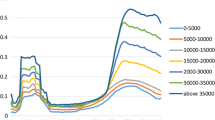Abstract
In this paper I build a simple model to analyze the consequences that population growth imposes on the relative needs of expenditure of governments in a fiscal federalism setup. I assume, first, that some government expenditure items can be classified according to the age of their recipient individuals and, second, that different levels of government are usually assigned different expenditure programs. The implication is that, for an initially given level of effective public good provision, changes in the size of population as well as in its age structure will influence the composition of public expenditure for different layers of administration in a different manner.
Similar content being viewed by others
References
Atkinson A, Stiglitz J (1980) Lectures on public economics. McGraw Hill, Maidenhead, pp 322–329
Auerbach A, Kotlikoff L (1983) National savings, economic welfare, and the structure of taxation. In: Behavioral simulation methods in tax policy analysis. NBER, pp 459–493
Auerbach A, Hagemann R, Kotlikoff L, Nicoletti G (1989) The dynamics of an aging population. The case of four OECD countries. Working Paper Series NBER No. 2797
Bergstrom T, Goodman R (1973) Private demands for public goods. Am Econ Rev 63:280–296
Blanchet D, Kessler D (1992) Optimal pension funding with demographic instability and endogenous returns to investment. In: Bös D, Cnossen S (eds) Fiscal implications of an aging population. Springer, Berlin Heidelberg New York
Blecha BJ (1987) The crowding parameter and the Samuelsonian publicness. J Polit Econ 95:622–631
Boadway R, Marchand M, Pestiau P (1992) Pay-as-you-go social security in a changing environment. In: Bös D, Cnossen S (eds) Fiscal implications of an aging population. Springer, Berlin Heidelberg New York
Borcherding T, Deacon R (1972) The demand for services of non-federal governments. Am Econ Rev 62:891–901
Bös D (1979) A voting paradox of fiscal federalism. J Public Econ 11:369–382
Bös D, von Weizsäcker R (1989) Economic consequences of an aging population. Eur Econ Rev 33:345–354
Bös D, Cnossen S (1992) Fiscal implications of an aging population. Springer, Berlin Heidelberg New York
Clark R, Kreps J, Spengler J (1978) Economics of aging. J Econ Literat 16:No 3
Creedy J, Disney R (1989) Can we afford to grow older? Eur Econ Rev 33:367–376
Cutler DM, Poterba JM, Sheiner LM, Summers L (1990) An aging society. Opportunity or challenge? Brook Papers Econ Activ 1:1–73
Dinkel RH (1984) Demographic influences on social security burden. In: Steinmann G (ed) Conference on population economics. Economic consequences of population change in industrialized countries, pp 87–107
Drissen E, van Winden F (1992) Social security in a general equilibrium model with endogenous government behavior. In: Bös D, Cnossen S (eds) Fiscal implications of an aging population. Springer, Berlin Heidelberg New York
Echevarría CA (1988) Descentralización de polítcas de estabilización. Herri Ekonomiaz — De Economía Pública No. 1, pp 137–160
Echevarría CA (1993) Taxation and age distribution of population in a life cycle growth model. Unpublished mimeo
Fair RC, Dominguez K (1991) Effects of changing US age distribution on macroeconomic equations. Am Econ Rev 81:1276–1294
Foot D (1984) The demographic future of fiscal federalism in Canada. Can Public Policy 70:406–414
Foot D (1989) Public expenditures, population aging and economic dependency in Canada: 1921–2021. Popul Res Policy Rev 8:97–117
González R, Means T, Mehay S (1993) Empirical tests of the Samuelsonian publicness parameter. Has the right hypothesis been tested? Public Choice 77:523–534
Kuznets S (1946) National income. A summary of findings. National Bureau of Economic Research, New York, Table 16
Musgrave RA, Musgrave PB (1984) Public finance in theory and practice. International Editions. Economic Series. McGraw Hill, Maidenhead
Oates W (1972) Fiscal federalism. Harcourt Brace Jovanovich, New York, Chap 1
OECD (1988) Le vieillisement démographique. Conséquences pour la politique sociale. Paris
Olson M (1969) The principle of ‘Fiscal equivalence’. The division of responsibilities among different levels of government. Am Econ Rev 59:479–487
Peters W (1992) Public pensions in transition. In: Bös D, Cnossen S (eds) Fiscal implications of an aging population. Springer, Berlin Heidelberg New York
Russell L (1982) The baby boom generation and the economy. The Brookings Institution, Washington, DC
Schoen R (1988) Modeling multigroup populations. Plenum Press, New York
Seidman L (1983) Taxes in a life cycle growth model with bequests and inheritances. Am Econ Rev 73:437–441
Summers LH (1981) Capital taxation and accumulation in a life cycle growth model. Am Econ Rev 71:533–544
Tobin J (1967) Life cycle saving and balanced growth. In: Ten economic studies in the tradition of Irving Fisher. John Wiley, New York
Waldo DR, Sonnefeld ST, McKusick DR, Arnett RH (1989) Health expenditures by age group, 1977 and 1987. Health Care Financ Rev 10:111–120
Wander H (1984) What does it cost to support the young and the old generations? In: Steinmann G (ed) Conference on population economics. Economic consequences of population change in industrialized countries, pp 238–257
Wise DA (1989) The economics of aging. NBER, The University of Chicago Press
Author information
Authors and Affiliations
Additional information
I would like to thank Jordi Caballé, Ángel de la Fuente, Javier Gardeazabal, Federico Grafe, Juan Urrutia and Jesús Vázquez for their valuable comments and suggestions. Two anonymous referees helped improve the initial version. Remaining errors and shortcomings are my own responsibility. Financial support from UPV 035.321-HA090/92 and UPV 035.321-HA130/93 is gratefully acknowledged.
Rights and permissions
About this article
Cite this article
Echevarría, C.A. On age distribution of population, government expenditure and fiscal federalism. J Popul Econ 8, 301–313 (1995). https://doi.org/10.1007/BF00185255
Received:
Accepted:
Issue Date:
DOI: https://doi.org/10.1007/BF00185255




